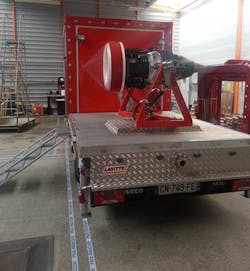Price Induction to Showcase Geared Turbofan Jet Engine on U.S. Tour
Price Induction will be touring the United Sates with their DGEN 380 turbofan engine on a mobile test bed. The DGEN 380 turbofan with all its operating equipment has been mounted on the platform of a truck and will be making demonstrations in numerous major cities this summer. The tour will provide a unique opportunity to see this next generation engine in operation and to learn more about the Price Induction advanced technologies used in the engine.
Cities already confirmed for demonstrations are:
- Atlanta GA - June 20
- Daytona Beach FL – June 23
- Raleigh NC – June 25
- Washington DC – June 27
- Chicago IL – July 21
- Cleveland OH – July 24
- University Park PA– July 28
The DGEN 380 targets the Personal Light Jet market for both certificated and experimental aircraft. Price Induction also provides several educational solutions such as the popular Virtual Test Bench, a high-technology simulation platform based on the DGEN 380. The engine and all the associated training solutions can be used by universities, aircraft maintenance schools, and research organizations for courses like engine operation training to acoustics and thermo-dynamics research.
To receive a full schedule of the touring and to receive your invitation to participate, contact Christine Lloyd at [email protected]
About the DGEN 380
Price Induction Inc. has been designing, over the past ten years, a small turbofan engine geared to the “PLJ” segment of the marketplace, the Personal Light Jet. To date the DGEN 380 engine test program has run more than 1,000 hours of testing. The engine is a twin-spool unmixed flow, high-bypass ratio turbofan engine, weighing only 175 pounds while providing 575 pounds of thrust.
The DGEN 380 incorporates a number of advanced technologies. First, it is a geared turbofan, which puts a planetary gearbox between the low pressure spool and the fan.
Secondly the DGEN incorporates an Integral Starter Generator, lowering the weight while making the nacelle diameter potentially smaller, because an output drive shaft and its associated hardware for connection to a generator, is eliminated. The technological innovations don't end there, as the fan and turbines form a “Blisk” ... a combination of blade and disk often machined from a single ingot, which dramatically reduces parts count.


